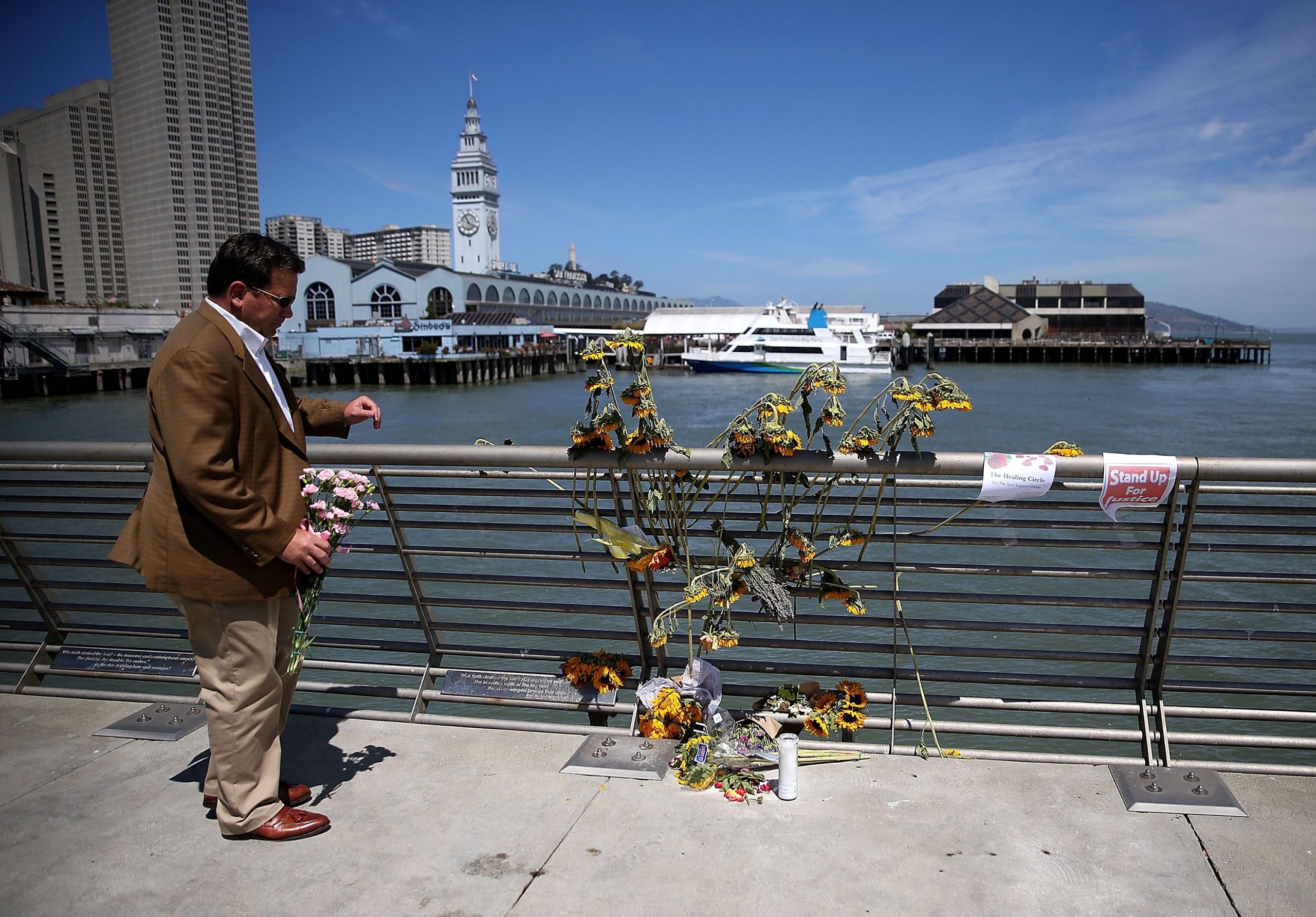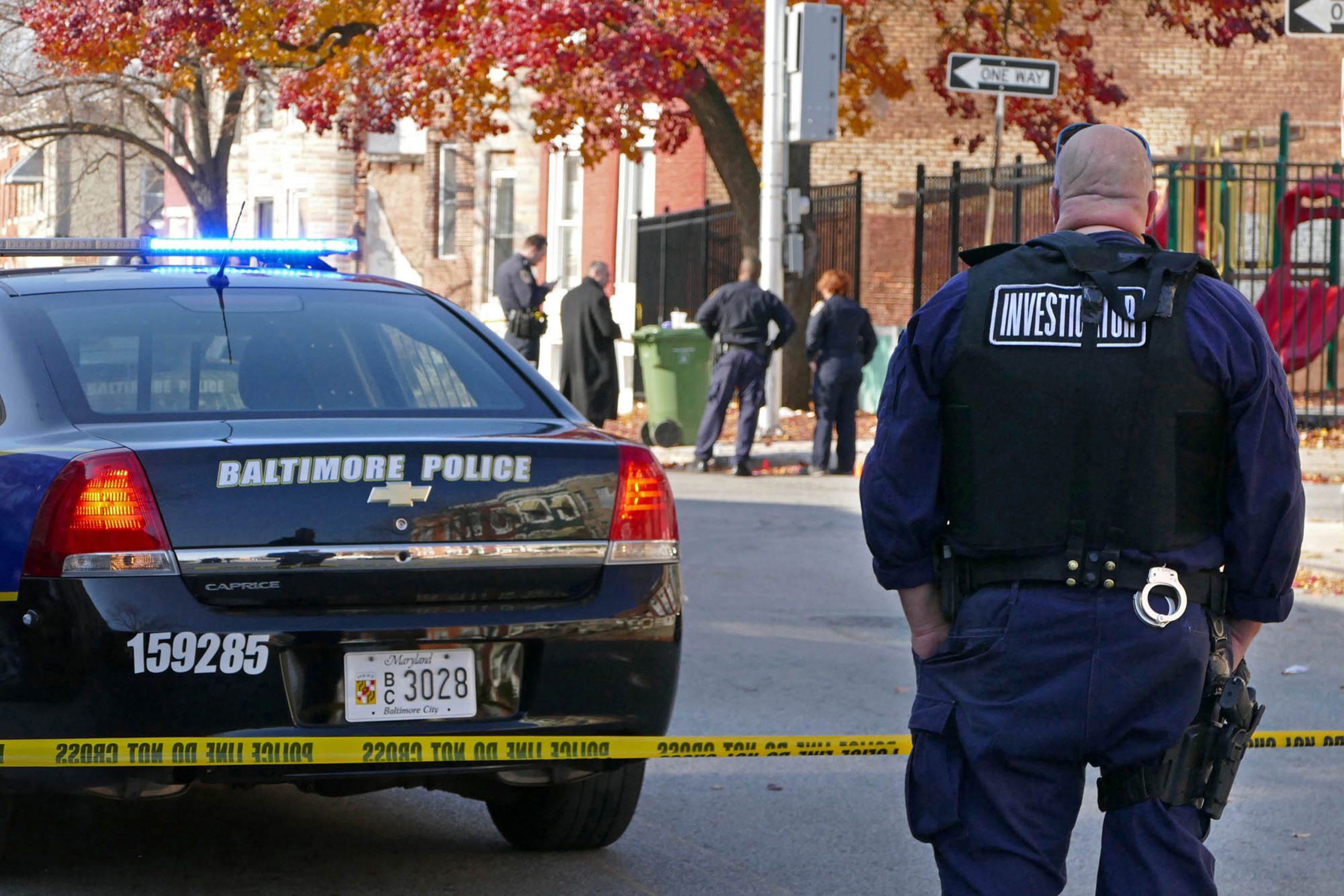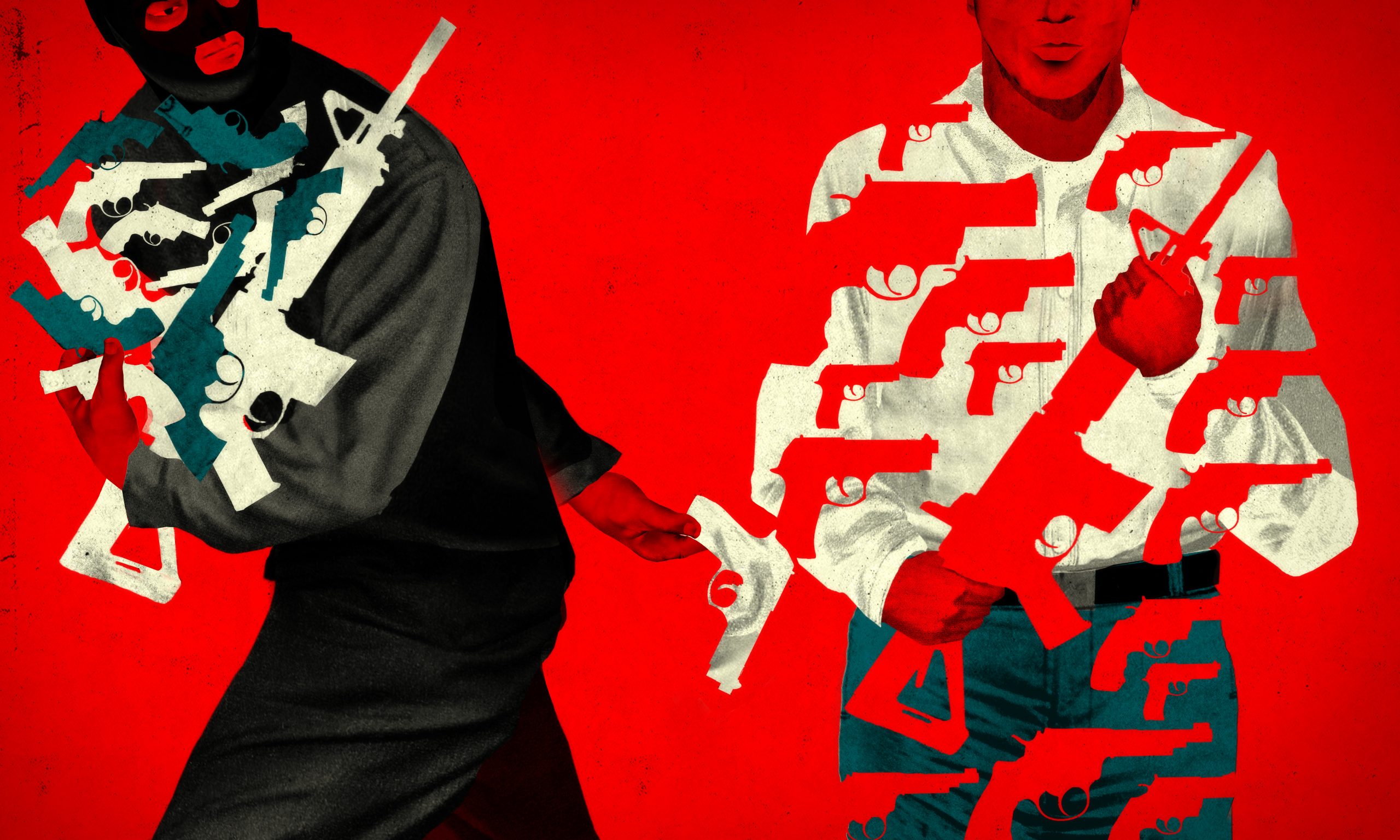Investigators were scouring the scene of a 2015 shooting in Southwest Baltimore when they found a blood-covered Glock pistol on the ground behind a row house. A ballistics analysis determined the gun had been used in the attack, which killed a 23-year-old man and injured a 93-year-old woman whose head was grazed by a stray bullet.
The Glock was a big break for investigators in the case, but a check of its serial number led to a chilling revelation: The gun belonged to one of their own. Two months earlier, a Baltimore police officer had reported the pistol stolen from his car.
Such thefts are not uncommon. The Trace examined records from more than 100 law enforcement agencies and found that they had collectively reported the loss or theft of at least 1,781 guns between 2008 and 2017. The vast majority were department-issued handguns, but the count also included hundreds of rifles and shotguns, as well as four fully automatic submachine guns. The firearms were stolen out of glove boxes and closets, left in airports and on the roofs of cars, and in one case, forgotten in a high school bathroom. Some were later involved in crimes ranging from aggravated assault to homicide.
The Trace’s investigation drew on thousands of pages of police reports, internal memos, inventory logs, and policy manuals from local and state law enforcement departments in 29 states and the District of Columbia, as well as from two federal agencies: Immigration and Customs Enforcement and the Drug Enforcement Administration. While the records covered just a sliver of the nearly 18,000 law enforcement agencies in the United States, the findings demonstrate that vague rules and haphazard security practices have resulted in guns flowing to the very criminals that officers are meant to contain.
Gun losses and thefts are a growing problem in the United States. According to the National Crime Information Center, a branch of the FBI, at least 249,501 firearms were reported lost or stolen in 2016, an increase of more than 62 percent over 2007. All told, at least 1.9 million guns were lost or stolen during that 10-year period.
The majority of thefts involve guns owned by civilians, as shown in The Trace’s 2017 stolen-guns investigation, reported in partnership with more than a dozen local NBC TV stations. Police guns compose a fraction of the annual total of stolen weapons, but experts say the problem is still significant, and can cast a shadow on the profession. David Hemenway, the director of the Harvard Injury Control Research Center, said officers who act irresponsibly with firearms are like doctors who smoke: not a large-scale health threat, but a symbolic example for the public. “There are enough people in the world who are careless about guns, so you want [police] to set a standard,” he said.
Nearly all of the lost and stolen law enforcement guns included in The Trace’s tally were department-owned or -issued, or had been qualified by officers for use on duty. A handful were officers’ personal weapons. The records indicate that at least 239 guns were eventually located. Agencies tracked down many weapons themselves, finding them in the trunk of a squad car, in a trash bin, or in the possession of a former employee. Citizens stumbled upon others. One officer’s stolen handgun was recovered at a park after it was snagged by a man’s fishing line. Another was found in the middle of a road by an 11-year-old boy.
About two dozen of the firearms surfaced in connection to other crimes, The Trace found. An AR-15 rifle snatched from an Illinois officer’s trunk turned up one year later in a domestic violence incident in Chicago, where a gang member fighting with his girlfriend about dinner threatened to kill her with the weapon. A .40-caliber Glock handgun taken from a Florida sheriff’s deputy’s car was involved in a 2015 gang-related shootout that killed a 29-year-old man. In another case, a handgun plucked out of a Maryland police sergeant’s bedroom drawer is believed to have been used to murder a 48-year-old nurse the next year.
The rise in civilian gun theft has prompted law enforcement to admonish people for leaving weapons in vehicles and other places frequently targeted by thieves. Departments have run campaigns trumpeting security measures and unwavering awareness as the hallmarks of responsible gun ownership. Last year, the Madison Police Department in Wisconsin put up a highway billboard featuring the slogan “LOCK IT or LOSE IT” sandwiched between a handgun and a set of keys. Police in Atlanta posted a video on YouTube reminding viewers that a car is a vulnerable place to stow a firearm.
But police have been guilty of similar levels of carelessness and disregard. Nearly half of the stolen law enforcement guns identified by The Trace were taken from cars. Officers stashed firearms in glove boxes and trunks, and left them on floorboards and seats, only to later discover them stolen. The Baltimore officer whose Glock was used in the 2015 fatal shooting of a 23-year-old man had stowed the pistol in the center console of his Dodge Charger so that he could play basketball; he discovered it missing before work the following afternoon but waited to report the theft until after his shift ended that night.
Some officers put down a weapon and forgot about it, as one might forget a cell phone or a set of keys. The Trace found at least a dozen incidents in which an officer drove off with a firearm resting on the hood or bumper of a car. One Missouri state trooper forgot a rifle on the side of a highway after stopping to help a stranded motorist. DEA agents left guns in a CVS restroom, in a Lyft car, and in the seat pocket of an aircraft. In 2011, a handgun fell out of an agent’s ankle holster while he was attending a concert in Chicago.
Richard W. Myers, the executive director of the Major Cities Chiefs Association, said departments take the issue of lost and stolen firearms seriously. “You’re talking about men and women who put their life on the line every day and have taken an oath to protect the public, and now they have something like that stolen, and it’s out there on the street,” Myers said. “That’s going to eat away at them.”
Firearms were nearly as likely to have been pilfered from officers’ homes as they were from a vehicle, The Trace found. Thieves crawled through windows, kicked down doors, or sneaked into open garages, and they took guns that officers kept on top of a bed or a refrigerator. One thief didn’t have to break in at all: The officer had left his weapon in a bookbag on his front porch. Rarely was the firearm secured under lock and key. In 2012, an Arizona officer arrived home from vacation to discover his service pistol had been stolen from his dresser drawer; he had locked the rest of his firearms in a safe, and they were untouched.
While research into storage policies as a deterrent for theft is scant, experts say it’s logical that guns shielded by locks are more difficult to steal, and police officers should be leading by example. “It is shocking to me that police would not store their guns safely at home,” said Dr. Frederick P. Rivara, an injury prevention expert at the University of Washington. “Everyone should agree that guns should not get into the hands of people who are not supposed to get them and should therefore be stored safely.”
The public safety threat posed by stolen law enforcement guns became a focus of national attention in 2015, after two people in the San Francisco Bay Area were fatally shot in separate incidents. Both of the killings involved guns stolen from the vehicles of federal agents. One of The Trace’s reporting partners, NBC Bay Area, surveyed eight state law enforcement agencies and uncovered more than 500 weapons that had gone missing over the previous six years. In its own reporting, the Bay Area News Group identified nearly 1,000 lost or stolen law enforcement weapons in the state between 2010 and 2016. Three months after that article ran, Governor Jerry Brown, a Democrat, signed a measure levying $1,000 fines on officers who fail to lock up guns stored in their cars.

Several agencies surveyed by the California news outlets were among those examined by The Trace, so some of our records overlap. California is overrepresented in our tally, in part because the police departments in San Jose and Oakland reported more than 650 gun losses and thefts over the time period we examined. But The Trace’s review also encompasses agencies from more than two dozen other states, amounting to one of the most sweeping analyses of lost and stolen law enforcement guns ever conducted.
A handful of states have imposed storage requirements on gun owners in certain situations, including whether they live with a child or a convicted felon. But lawmakers have rarely addressed how officers should be securing their weapons, and across wide swaths of the country, they are under no legal obligations at all.
The lack of storage mandates means that law enforcement agencies must fashion their own rules. Some departments are explicit about how their officers must store their guns. In Florida, the Brevard County Sheriff’s Office requires employees to maintain “direct physical control” over all weapons unless they are locked up, and bans the storing of department-issued guns in personal vehicles altogether. Other departmental policies are more vague, failing to spell out how guns should be stored or which storage locations to avoid. The Wichita Police Department in Kansas calls for officers to keep their guns “properly secured at all times,” but only specifies that a safe must be used at home if an officer expects to be gone for more than seven days. The Baltimore Police Department prohibits keeping handguns in vehicles unless they’re stowed in a gun locker, but otherwise allows them to be stored as officers see fit, so long as the weapons are inaccessible to unauthorized users.
In at least one case identified by The Trace, ambiguity in a department’s storage policy became a point of contention. After a Washington State Patrol lieutenant’s Smith & Wesson handgun was taken from a Portland, Oregon, hotel room in 2011, he criticized the agency’s policy as providing “no guidance or direction regarding the specific means” for securing guns, and recommended the policy be updated. Asked to comment on this case, an agency spokesperson told The Trace that the policy had not been revised. “If employees have questions, they are expected to consult with their supervisor,” the spokesperson wrote.
There are dozens of federal law enforcement agencies in the United States, and no agreed-upon standards for how their employees should guard their weapons. The DEA said it treated each loss and theft “very seriously” and took “corrective action” to ensure its firearm storage policy was followed in the future, but the agency refused to disclose that policy, arguing that its release would create “an obvious safety issue both for agents and for the general public.” Several police departments and sheriff’s offices, however, post their policy manuals online. The FBI denied The Trace’s request for records pertaining to the bureau’s lost and stolen guns, saying it would “neither confirm nor deny the existence of any records” that would detail the agency’s “non-public” law enforcement practices.
Contact Us
Learn how to contact our reporters securely.
Another federal agency, Immigration and Customs Enforcement, tallied at least 140 guns lost or stolen between 2010 and 2016, according to records obtained by The Trace. In a statement, ICE said agents were required to regularly review its firearms policy and complete web-based training on the proper handling of guns and other sensitive equipment. “Above all else, ICE’s policies and procedures regarding firearms are continuously reviewed and updated to mitigate loss/theft and ensure public safety — which is and will always be a top priority,” the agency wrote.
The patchwork of gun storage policies prompted Representative Mark DeSaulnier, a Democratic congressman from California, to re-introduce legislation in 2017 that would set minimum safe storage standards among federal law enforcement agencies, including a requirement to use safes and lockboxes and refrain from keeping firearms in vehicles. “People are dying,” DeSaulnier told The Trace. “And in my view, and in the view of many others … many of these deaths are needless.”
DeSaulnier’s bill has idled in committee.
Officers punished for losing a gun or not storing one securely were usually given a written reprimand or assigned counseling, The Trace found. Suspensions were less common, and seldom lasted more than three days. The Denver Police Department, for example, suspended a detective for two days after she left her weapon in a high school bathroom, where it was found by an administrator. Records from the Atlanta Police Department showed that in 55 cases in which officers reported a lost or stolen firearm between 2010 and 2018, the vast majority resulted in an oral admonishment, a written reprimand, or no action. Six incidents led to the officer being suspended, while three investigations were still pending when the records were released.
In response to inquiries from The Trace, Atlanta Police Chief Erika Shields sharply increased penalties for violations of the department’s gun storage rules, exposing officers to $500 fines and a minimum three-day suspension. In a statement, Shields said stolen guns posed a threat not only to the residents of the city but also to the officers who confronted armed criminals. “When an officer fails to secure his or her firearm, it bothers me greatly,” Shields added. “We should know better, and I expect more of our personnel.”
Hundreds of department-issued firearms were not discovered missing until the agencies audited their stocks, and such audits sometimes turned up loose security measures and sloppy record-keeping. When the Des Plaines Police Department in Illinois was trying to locate two M16 rifles in 2014, officers realized that the weapons had not been properly documented for seven years, and they weren’t sure when the guns were last seen. Moreover, more than two dozen officers had keys to the department’s armory, and a video camera focused on the armory door had been “deliberately disabled … so that the connection could be repurposed.” A similar scenario played out last year at the Baker County Sheriff’s Office in Florida. A captain determined that the previous administration’s records were “incomplete with no sense of organization or sequential order,” and that security of the armory was “non-existent.” The audit identified 11 firearms that had gone missing, and found 17 other weapons that the department had no record of owning.
In several cases of inventory losses reviewed by The Trace, audits were prompted by a federal program requiring departments that accept surplus military rifles and other equipment to inventory their stocks annually.
Jerry Hill, a Democratic state senator from San Mateo, introduced a bill in California in 2016 that would have forced law enforcement agencies in that state to follow more robust firearm tracking procedures, but the bill died after concerns that the requirements would be too costly for agencies. The senator introduced a similar bill this year. “There is something wrong here,” said Hill, who also authored the legislation cracking down on California officers who store firearms in vehicles. A gun “needs to be protected, it needs to be secured, and it needs to be out of the hands of those who will use it for the wrong reasons.”

